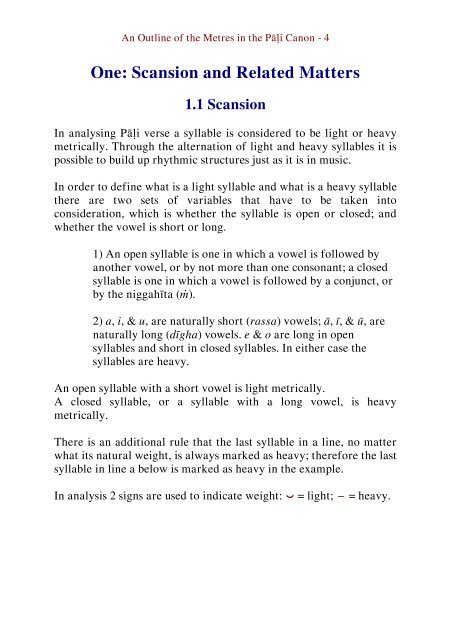An Outline of the Metres in the Pāḷi Canon
A concise but thorough explanation of the metres that are found in the Pāli canon, along with examples and glossary.
A concise but thorough explanation of the metres that are found in the Pāli canon, along with examples and glossary.
You also want an ePaper? Increase the reach of your titles
YUMPU automatically turns print PDFs into web optimized ePapers that Google loves.
<strong>An</strong> <strong>Outl<strong>in</strong>e</strong> <strong>of</strong> <strong>the</strong> <strong>Metres</strong> <strong>in</strong> <strong>the</strong> <strong>Pāḷi</strong> <strong>Canon</strong> - 4<br />
One: Scansion and Related Matters<br />
1.1 Scansion<br />
In analys<strong>in</strong>g <strong>Pāḷi</strong> verse a syllable is considered to be light or heavy<br />
metrically. Through <strong>the</strong> alternation <strong>of</strong> light and heavy syllables it is<br />
possible to build up rhythmic structures just as it is <strong>in</strong> music.<br />
In order to def<strong>in</strong>e what is a light syllable and what is a heavy syllable<br />
<strong>the</strong>re are two sets <strong>of</strong> variables that have to be taken <strong>in</strong>to<br />
consideration, which is whe<strong>the</strong>r <strong>the</strong> syllable is open or closed; and<br />
whe<strong>the</strong>r <strong>the</strong> vowel is short or long.<br />
1) <strong>An</strong> open syllable is one <strong>in</strong> which a vowel is followed by<br />
ano<strong>the</strong>r vowel, or by not more than one consonant; a closed<br />
syllable is one <strong>in</strong> which a vowel is followed by a conjunct, or<br />
by <strong>the</strong> niggahīta (ṁ).<br />
2) a, i, & u, are naturally short (rassa) vowels; ā, ī, & ū, are<br />
naturally long (dīgha) vowels. e & o are long <strong>in</strong> open<br />
syllables and short <strong>in</strong> closed syllables. In ei<strong>the</strong>r case <strong>the</strong><br />
syllables are heavy.<br />
<strong>An</strong> open syllable with a short vowel is light metrically.<br />
A closed syllable, or a syllable with a long vowel, is heavy<br />
metrically.<br />
There is an additional rule that <strong>the</strong> last syllable <strong>in</strong> a l<strong>in</strong>e, no matter<br />
what its natural weight, is always marked as heavy; <strong>the</strong>refore <strong>the</strong> last<br />
syllable <strong>in</strong> l<strong>in</strong>e a below is marked as heavy <strong>in</strong> <strong>the</strong> example.<br />
In analysis 2 signs are used to <strong>in</strong>dicate weight: ⏑ = light; − = heavy.

















